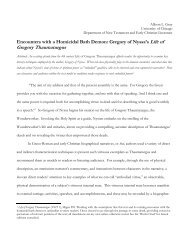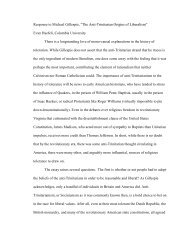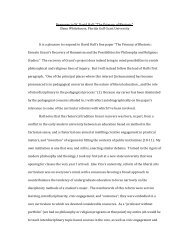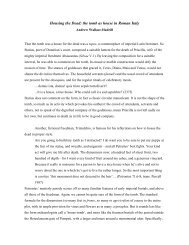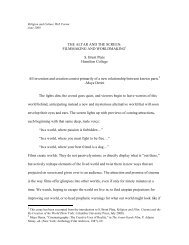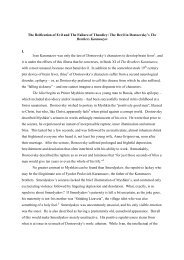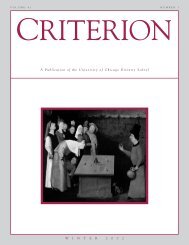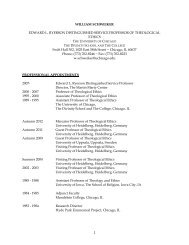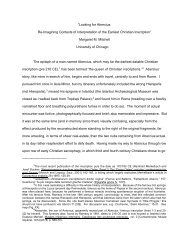Monotheism For Religion And Culture-1 - Divinity School ...
Monotheism For Religion And Culture-1 - Divinity School ...
Monotheism For Religion And Culture-1 - Divinity School ...
You also want an ePaper? Increase the reach of your titles
YUMPU automatically turns print PDFs into web optimized ePapers that Google loves.
The Uses and Misuses of Polytheism and <strong>Monotheism</strong> in Hinduism<br />
by Wendy Doniger<br />
To the question, “Is Hinduism monotheistic or polytheistic?” the best answer is,<br />
“Yes” (which is actually the answer to most either/or questions about Hinduism). Not<br />
only have elements of both theologies been woven through Hindu texts for thousands of<br />
years, but different factions have argued passionately for one view and against the other<br />
during this entire period, and the issue still raises Hindu hackles today. The force of the<br />
passion comes from the political issues that have often driven this question, particularly<br />
since the time of the British Raj and now again in the Age of the Internet.<br />
Hindu texts began with the Rig Veda (“Knowledge of Verses”), composed in<br />
Northwest India in around 1500 BCE; the first of the three Vedas, it is the earliest extant<br />
text composed in Sanskrit, the language of ancient India. At first glance, it would seem<br />
to be unequivocally polytheistic: there are certainly many gods. Indra is the king of the<br />
gods and god of the rain (much like his Greek and Roman cousins Zeus and Jupiter);<br />
Varuna the god of the heavenly vault and the moral law (related to the Greek Ouranos);<br />
Agni the god of fire (cf. the Latin ignis, and the English “ignite”); and so forth. Each<br />
individual worshiper would know, and might use, several different poems to different<br />
gods. Always there was an awareness of the multiplicity of the gods. At time of war, or<br />
drought, one prayed to Indra; in a sacrifice, one invoked Agni (the sacrificial fire); and so<br />
forth. We can detect both what might be called internal polytheism (one person<br />
worshipping several gods) and communal polytheism (several people worshipping<br />
several gods and respecting, or at the very least acknowledging the existence of, one<br />
another’s gods).<br />
1
But the polytheism of Vedic religion sometimes functioned as a kind of serial<br />
monotheism that the Vedic scholar Friedrich Max Müller (1823-1900) named<br />
“henotheism” or “kathenotheism,” the worship of a number of gods, one at a time,<br />
regarding each as the supreme, or even the only, god while you are talking to him. Thus,<br />
one Vedic poem will praise a god and chalk up to his account the credit for separating<br />
heaven and earth, propping them apart with a pillar, but another Vedic poem will use<br />
exactly the same words to praise another god. (In addition, each god would have<br />
characteristics and deeds that were his alone; no one but Indra kills the demonic serpent<br />
of drought.) Bearing in mind the way in which the metaphor of adultery has traditionally<br />
been used by monotheistic religions to stigmatize polytheism (“whoring after other<br />
gods”), and used by later Hinduism to characterize the love of god (as in the Bengali<br />
tradition of Krishna and Radha), we might regard this attitude as a kind of theological<br />
parallel to serial monogamy, or, if you prefer, open hierogamos: “You, Vishnu, are the<br />
only god I've ever worshiped; you are the only one.” “You, Varuna, are the only god I've<br />
ever worshiped; you are the only one.” “You, Rosaline, are the only woman I've ever<br />
loved; you are the only one.” “You, Juliet, are the only woman I've ever loved; you are<br />
the only one.” The idea of “the [only] one” as applied to several different members of a<br />
polytheistic pantheon also appears in some of the later verses of the Rig Veda: “They call<br />
it Indra, Mitra, Varuna, Agni, and it is the heavenly bird that flies. The wise speak of<br />
what is One in many ways; they call it Agni, Yama, Matarishvan.” [1.164.46] 1<br />
The idea that one could choose between members of a pantheon of gods was<br />
integral to Vedic religion. <strong>For</strong> example, each stanza of one Vedic poem ends with the<br />
questioning refrain, “Who is the god whom we should worship with the oblation?”<br />
2
Thus: “He by whom the awesome sky and the Earth were made firm, by whom the dome<br />
of the sky was propped up, and the sun, who measured out the middle realm of space—<br />
who is the god whom we should worship with the oblation?” [10.121] The Atharva Veda,<br />
too, a fourth Veda composed in around 900 BCE, asked not only who the god was, but<br />
how many gods there might be: “Who and how many were those Gods who fastened<br />
together the chest and neck of the Primeval Man? How many fixed his breasts? Who<br />
formed his elbows? How many joined together ribs and shoulders?” [10.2.4]<br />
The texts that followed the Vedas, called the Brahmanas (mythological,<br />
philosophical, and ritual glosses on the Vedas), were composed at a time (c. 800 BCE)<br />
when the Brahmin priests had taken on greater control and influence; troubled by the<br />
open-ended refrain of the Rig Vedic poem, they invented a god whose name was the<br />
interrogative pronoun Who (ka, cognate with the Latin quis, French qui). Read back into<br />
the Vedic poem (as it was in later Vedic commentaries 2 ), this resulted in an affirmative<br />
statement: “Indeed, Who is the god whom we should honor with the oblation,”<br />
somewhat reminiscent of the famous Abbott and Costello routine ("Who's on first?").<br />
This sacerdotal arrogance closed down some of those openings through which fresh<br />
theological air had flowed in the Veda. The question became the answer.<br />
Then the Upanishads, composed a few centuries later, partially in reaction against<br />
the priestly control of the Brahmanas, opened it up again, and began to ask new<br />
questions, including the Atharva Veda’s polytheism question: “how many?” The gods<br />
were often called "The Thirty-Three" (rather like The Four Hundred, the closed canon of<br />
blue-blooded families in New York, or the <strong>For</strong>bes Five Hundred companies). But the<br />
Upanishads mocked this number—and mocked polytheism altogether—with a dialogue<br />
3
in which, in response to the pupil's repeated question, "But how many gods are there,<br />
really?" the increasingly impatient teacher replies, first, "Three hundred and three, and<br />
three thousand and three," then "Thirty-three," then, "Six," then, "Three," then, "Two,"<br />
then, "One and a half," and, finally, “One." 3<br />
This “One” is the emblem not of monotheism but of Upanishadic monism, which<br />
assumes that all living things are elements of a single, universal being (often called<br />
brahman), reached by individual meditation, a philosophy often contrasted with the<br />
polytheistic world of group sacrifice to multiple gods. The doctrine of the Upanishads is<br />
also sometimes characterized as pantheism (in which God is everything and everything is<br />
God) or, at times, panentheism (in which God encompasses and interpenetrates the<br />
universe but at the same time is greater than and independent of it). <strong>And</strong> as the<br />
Upanishads are “the end of the Vedas” (Vedanta), Upanishadic philosophy is also called<br />
Vedanta. These Vedantic doctrines view the very substance of the universe as divine, and<br />
view that substance and that divinity as unitary. They stand in contrast both with Vedic<br />
polytheism and with the sort of monotheism that posits a single deity with consciousness<br />
and/or a physical form (like some of the deities of the medieval Hindu movement known<br />
as bhakti, or devotionalism). The vague monism of the Vedas was sharpened by the<br />
more systematized Vedantic monism of the Upanishads. 4 The term “Vedanta” later<br />
came to be applied to the philosophy of Non-Dualism (that is, the doctrine that there is no<br />
distinction between the soul and brahman), particularly to the teachings of Shankara<br />
(788-820), whose teachings may have been buoyed up by a need to respond to the<br />
monotheist philosophies of Islam. Shankara’s competitors argued that he championed<br />
monism because he was so stupid that he could only count to one. 5<br />
4
But monism and polytheism, growing up side by side as they did in ancient India,<br />
learned to live together, to grant one another’s existence. Monists acknowledged the<br />
reality of the gods of the pantheon but accorded them a secondary, illusory status in<br />
comparison with the enduring, real status of the underlying monistic being. Thus the<br />
many gods of the Hindu pantheon were often grouped under a monistic umbrella, so that<br />
all gods are said to be aspects of one particular god (sometimes Vishnu, sometimes<br />
Shiva) or, more often, aspects of the universal, ineffable brahman. At other times,<br />
individual, effable gods are said to be the manifestations of the true god that is “without<br />
qualities” (nir-guna), but the manifestations are “with qualities” (sa-guna)—with names,<br />
adventures, distinct appearances.<br />
All of these theological variations, and many more, appear in the Puranas, the<br />
encyclopedic Sanskrit (and, later, vernacular) texts that expound the myths, rituals, and<br />
philosophies of sectarian Hinduism. Here we encounter the several avatars (incarnations)<br />
of Vishnu, which make Vishnu a kind of walking one-god polytheism; at times he<br />
appears as a fish, as a boar, as various human beings (Rama, Krishna, even the Buddha),<br />
all of which were originally individual deities who later became absorbed into the over-<br />
arching figure of Vishnu. His incarnations are often said to be “partial”: while Vishnu<br />
appears as Krishna, for instance, the god Vishnu also remains in his heaven, entirely<br />
complete. In contrast with the complete lives that Vishnu takes on in his avatars, the god<br />
Shiva becomes multiple by manifesting himself in various forms, usually during<br />
relatively brief masquerades. <strong>And</strong> although the goddesses of India are as various as the<br />
gods, people—both scholars and the Hindu texts—often speak of the Goddess, Devi, and<br />
tend to treat all the goddesses as nothing more than aspects of Devi. One gets the<br />
5
impression that, in the dark, all goddesses are gray. So, too, while gods, ogres and anti-<br />
gods often have multiple heads—Brahma has four, Shiva five, Skanda six, Ravana ten—<br />
Hindu goddesses not only seldom have more than one—they have lots of arms, but not<br />
heads—but often less than one: several of them are beheaded. This is a gendered pattern<br />
that makes one stop and think.<br />
Eventually, the monistic view of the universal brahman turned itself inside out to<br />
generate another sort of universalism: it argued not only that all physical and immaterial<br />
things were one, but that all religions were essentially the same, or, as it were, one, that<br />
Muslims and Christians really worshipped the same god that Hindus worshipped, but just<br />
called him Allah or Christ. This belief entered India by the 12 th century when Sufism (a<br />
mystical form of Islam) proclaimed that Muslims, Christians, Jews, Zoroastrians, and<br />
Hindus were all striving toward the same goal and that the outward observances that kept<br />
them apart were false. The Mughal emperor Akbar (1556-1605) sponsored religious<br />
debates between different Muslims groups (Sunni, Shia and Ismaili, as well as Sufis),<br />
Parsis, Hindus (devotees of Shiva and of Vishnu), Sikhs, Jains, Jews, Jesuits, and<br />
Materialists, but was particularly partial to Sufism. He proclaimed that “the wisdom of<br />
Vedanta is the wisdom of Sufism,” 6 thus further universalizing the two great<br />
universalizing religions by equating (which is to say universalizing) them.<br />
When the British took over India from the Mughals, they too entered the arena<br />
where polytheism, monism, and universalism were duking it out. The officers and<br />
missionaries under the British Raj—who were, by and large, not just Protestants but<br />
Victorian Protestants—regarded polytheism as just one more form of Oriental excess, all<br />
those arms, all those heads—all those gods. Moreover, Hindu polytheism reminded them<br />
6
of Catholicism (which Hinduism resembles uncannily in many ways)—all those saints,<br />
all those relics. (Compare, for example, the Hindu myth in which a woman is beheaded<br />
and her head, joined to another body, becomes one goddess, while her body, joined to<br />
another head, becomes another goddess, 7 with the story of Catherine of Siena [1347-<br />
1380], whose head is entombed in Siena, her body in Rome.) European translations of<br />
Indian texts had begun in the 18 th century with a fittingly fraudulent document: the so-<br />
called “Ezour Veda” (presumably a corruption of theYajur Veda, the third Veda), a<br />
French text in the form of a dialogue between two Vedic sages, one monotheist and one<br />
polytheist, who find that the monotheism of “pristine Hinduism” points to Christian truth.<br />
Voltaire was deeply impressed by it and cited it often. 8 Its authorship remains unknown,<br />
but it is now certain that it was an original French composition that claimed to be a copy<br />
of a lost Sanskrit text—monotheism masquerading as polytheism concealing<br />
monotheism.<br />
The fraction of Hinduism that appealed to Protestant, Evangelical tastes at all was<br />
firmly grounded in philosophical monism. The Evangelists in India assumed that God<br />
had prepared for their arrival by inspiring the Hindus with a rough form of monotheism–<br />
the monism of the Upanishads; pukka monotheism, in their view, was available to<br />
Brahmins but not to the lower castes, who were fit only for polytheism. 9 The British<br />
tended to prefer the company of Muslims to Hindus for a number of reasons, including<br />
the simple fact that Islam was a monotheism that revered the Hebrew Bible and the<br />
Christian New Testament. Some Protestants within the British Raj tried to recast<br />
Hinduism as a monotheism, with a Bible: the Bhagavad Gita (a part of the great Sanskrit<br />
epic, the Mahabharata), a metaphysical dialogue between the human hero Arjuna and<br />
7
Krishna, a human incarnation of Vishnu. By positioning the Gita as the Hindu Bible, the<br />
British also validated the worship of Krishna/Vishnu as a form of monotheism. But<br />
focusing on this single text ignored not only the many other texts in which other gods,<br />
such as Shiva, were similarly represented as the one and only god, but other parts of the<br />
very text in which the Gita occurs, the Mahabharata, in which Shiva and other gods<br />
reveal their powers. Moreover, the Gita had never had anything remotely approaching<br />
canonical status before this, though it had always been an important text. Other texts—<br />
Sanskrit texts like the Upanishads and vernacular texts such as the Hindi and Tamil<br />
version of the Ramayana (the other great Sanskrit epic), and, most of all, oral traditions–<br />
were what most Hindus actually used in their worship. The British exclusionary focus on<br />
the Gita, and on Krishna/Vishnu, amounted to mistaking kathenotheistic polytheism for<br />
monistic monotheism.<br />
Scholars have noted a pattern in which colonized people take on the mask that the<br />
colonizer creates in the image of the colonized, mimicking the colonizer’s perception of<br />
the colonized. 10 Many highly-placed Hindus so admired their colonizers that, in a kind<br />
of colonial and religious Stockholm syndrome, they swallowed the Protestant line<br />
themselves, and not only gained a new appreciation of those aspects of Hinduism that the<br />
British approved of (the Gita, the Upanishads, monism), but became ashamed of those<br />
aspects that the British scorned (polytheism, erotic sculptures on temples, devadasi<br />
temple dancers). Following the British lead, they gave the Gita a primacy it had not<br />
previously enjoyed, and in lifting up this monolithic form of Hinduism, they trampled<br />
down and largely wrote off the dominant strain of Hinduism that celebrated the<br />
multiplicity of the divine, the plurality of forms of worship. But they could not kill it;<br />
8
indeed, most Hindus of this type didn’t even know that they were regarded as either<br />
beneath contempt or entirely non-existent. They went on worshipping their gods, singing<br />
their songs, telling their stories.<br />
But the highly Anglicized Indian elite developed new forms of Hinduism heavily<br />
influenced by British Protestantism. The key figure in this movement was Rammohan<br />
Roy (1772-1833), who cast aside the polytheistic Hinduism of his family and turned to<br />
monotheism instead. His intense belief in strict monotheism and his aversion to Puranic<br />
Hinduism (small shrines in the house, temple worship, pilgrimage) began early. It was<br />
derived from a combination of monistic elements of Hinduism and Islam (he had studied<br />
the Qu'ran as well as the Vedas and the Upanishads) and, later, 18th-century Deism<br />
(belief in a transcendent Creator God reached through reason), Unitarianism (belief in<br />
God’s essential oneness), and the ideas of the Freemasons (a secret fraternity that<br />
espoused some Deistic concepts). In 1804, he published a tract in Persian, Tuhfat' ul<br />
muhwahiddin (A Gift to Monotheists). Influenced by his fascination with tawhid, the<br />
Islamic idea of the absolute unity of God, he began issuing critiques of the polytheism of<br />
the Hindus and searching Hindu texts for traces of monotheism, trying to prove that<br />
textual references to polytheism ("idolatry") were purely allegorical whereas references<br />
to an overarching Supreme Deity were the essential nexus of Hinduism. His beliefs were<br />
further fueled by his realization that the colonial government viewed Hindu customs<br />
alternately with abhorrence (Vedic polytheism) and fascination (Vedantic monism), and<br />
by his desire to rebut the scathing critiques of the missionaries.<br />
Rammohan Roy formulated a new Hinduism, called the Brahmo Samaj<br />
(“Assembly of God”), which extracted the Sufism from Islam, the Vedanta from<br />
9
Hinduism, and Unitarianism from Christianity. Much of his thought influenced Hindus<br />
far beyond the bounds of the Brahmo Samaj, inspiring the form of Hinduism called<br />
Sanatana Dharma (Eternal or Universal Dharma,) or Neo-Vedanta, embraced by many<br />
Hindus to this day. A related form of Neo-Vedanta was carried to Europe and America<br />
by Swami Vivekananda (1863-1902), who made a deep impression at the World<br />
Parliament of <strong>Religion</strong>s in Chicago in 1893. Vivekananda took up the famous Vedic line<br />
about the multiplicity of the gods ("The wise speak of what is One in many ways"),<br />
which clearly presupposes a polytheistic pantheon, cited it out of context, made it refer<br />
not to a divine force but to an enlightenment force ("Truth is one; sages speak of it<br />
variously"), and invoked it in defense of the argument that the Rig Veda was<br />
monotheistic. 11 (Vivekananda’s version was the one quoted by Lisa Miller in her August<br />
15, 2009, Newsweek article, “We Are All Hindus Now”: “Truth is One, but the sages<br />
speak of it by many names.”) Vivekahanda’s Hinduism jettisoned the particulars of<br />
Hindu polytheism (doctrines, dogmas, rituals, books, oral traditions, and temples) in<br />
order to extract a universal essence of "spirituality."<br />
In our day, as fundamentalism raised its ugly head among the major monotheisms<br />
(Judaism, Christianity, and Islam), Hinduism, too, caught it. The movement known as<br />
Hindutva (“Hindu-ness”), while protesting that it is a reaction against European<br />
pressures, actually apes Protestant evangelical strategies, including fundamentalist<br />
agendas. Their hatred is directed not only against Hindus of the more diverse traditions<br />
but also, ironically, against the very monotheisms that started the rot (including the<br />
insistence that Hinduism is monotheistic) in Hinduism: Islam and Christianity. As some<br />
critics of contemporary Hindu revisionism noted, “By spelling God with a capital letter<br />
10
they are trying to position Hinduism as monotheistic, making it look more ‘modern.’ ” 12<br />
But of course, it is anything but modern; the argument about Hindu polytheism and<br />
monotheism is as old as Hinduism itself. Nor has Hindutva had the last word.<br />
Nowadays Hindus in India and throughout the diaspora worship the goddess Durga on<br />
the days of Durga Puja, Shiva on the nights of Shivaratri, and Ganesha when they begin<br />
any new enterprise. Many of them go to church on Christmas eve and worship at the<br />
shrines of Sufi pirs from time to time. Many of them, as a 1911 Gazeteer remarked of the<br />
relationship to Hinduism and Islam of one particular group, “keep the feasts of both<br />
religions and the fasts of neither.” 13 The genius of Hinduism, its malleability and<br />
diversity, continues to give it a terrific edge over those branches of the monotheistic<br />
religions (Judaism, Christianity, Islam) that are strait-jacketed by a single canon (Bible or<br />
Qu’ran), and/or a single governing body (Pope or Ulama), and, above all, a single god.<br />
1 Wendy Doniger O'Flaherty, The Rig Veda: An Anthology (Harmondsworth: Penguin<br />
Books, 1981), p. 80. ekam sad vipra bahu vadanti.<br />
2 Sayana's commentary on Rig Veda 1.121. Rig Veda, with the commentary of Sayana. 6<br />
vols. London: Oxford University Press, 1890-92<br />
3 Brihadaranyaka Upanishad 3.9.1. In Patrick Olivelle, ed. and trans., Early Upanishads.<br />
New York: Oxford University Press, 1998.<br />
4 I am using the terms "Vedanta" and “Vedantic” here to designate the strain of Indian<br />
philosophy that begins with the Upanishads, climaxes with the great commentaries of<br />
Shankara and Ramanuja, and survives in the thought of Neo-Vedantins such as<br />
Ramakrishna and Vivekananda. <strong>And</strong> by Vedic I mean not merely the Vedas but the<br />
11
entirely strain of Hinduism that endorses Vedic sacrifice and the worship of a pantheon of<br />
gods, as it is carried on to this day in Hindu temples and households.<br />
5 G. A. Grierson, “Madhvas.” In Hastings’ Encyclopedia of <strong>Religion</strong> and Ethics, 8:232-<br />
5.<br />
6 Anne-Marie Schimmel, The Empire of the Great Mughals: History, Art, and <strong>Culture</strong><br />
(London: Reaktion Books, Ltd, 2004), 113, citing Akbar.<br />
7 See the Renuka myth in Wendy Doniger, Splitting the Difference: Gender and Myth in<br />
Ancient Greece and India (Chicago: The University of Chicago Press, 1999), 204-231.<br />
8 Ludo Rocher, ed. and intro. Ezourvedam: A French Veda of the Eighteenth Century<br />
(Amsterdam/Philadelphia: J. Benjamins Pub. Co., 1984), 3, 19. The text was published<br />
in Asiatic Researches, Royal Asiatic Society, Bengal, 1822.<br />
9 Partha Mitter, “Rammohun Roy and The New Language Of <strong>Monotheism</strong>.” History and<br />
Anthropology, 3 (1987), 177-208.<br />
10 Ashis Nandy, The Intimate Enemy: Loss and Recovery of Self Under Colonialism.<br />
Delhi: Oxford University Press, 1983.<br />
11 Swami Vivekananda, The Complete Works of Swami Vivekananda (Calcutta: Advaita<br />
Ashrama 1971-73), vol. 1, p. 348.<br />
12 San Francisco Chronicle, “A Different Agenda,” by Romila Thapar and Michael<br />
Witzel, March 6, 2000, about the attempts of the Hindu Sangha to alter school textbooks<br />
in the United States.<br />
13 Punjab District Gazetteer, vol. IV A: Gurgaon District (Lahore: Civil and Military<br />
Gazette Press for the Punjab Government, 1911), p. 70. No author is attributed. The<br />
reference is to the Meos, a group of Muslims in Gurgaon. Thanks to David Lelyveld for<br />
this reference.<br />
12




